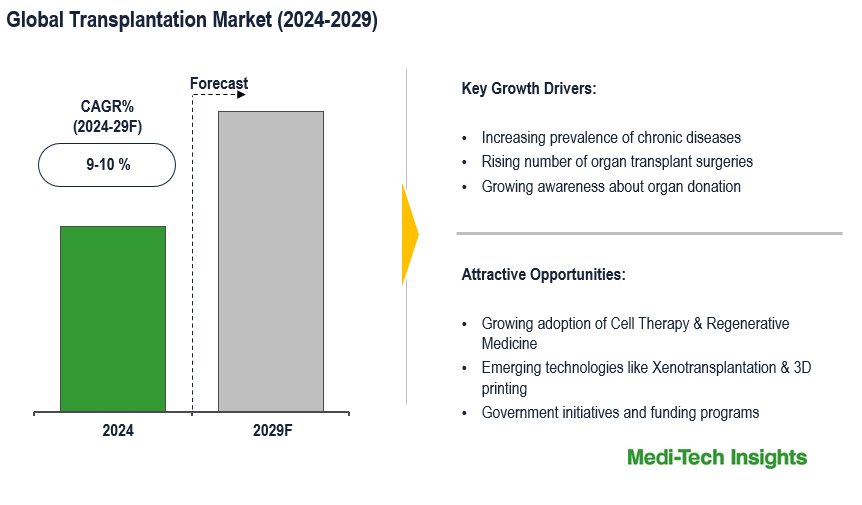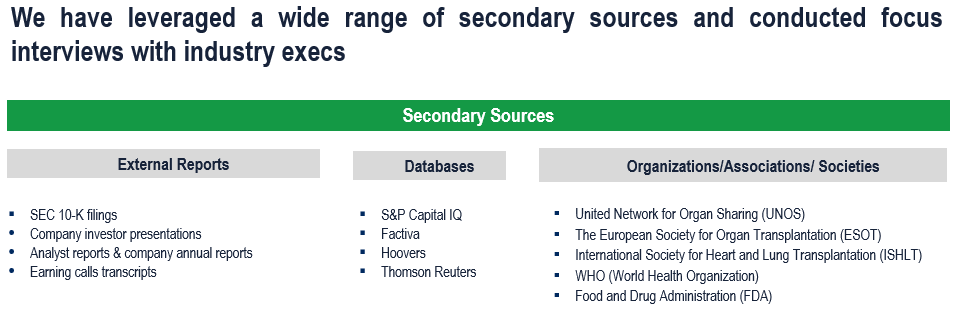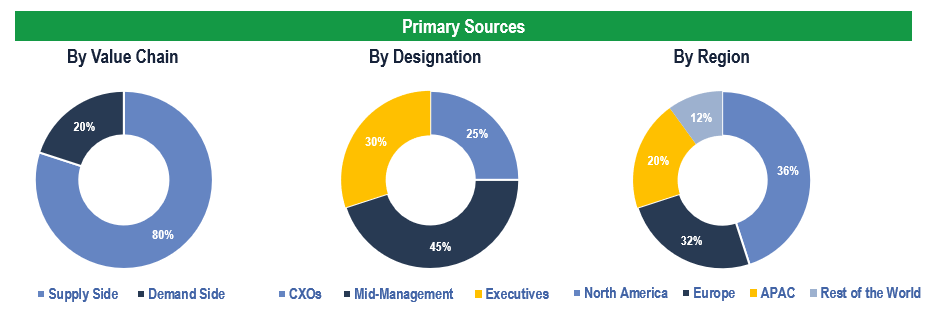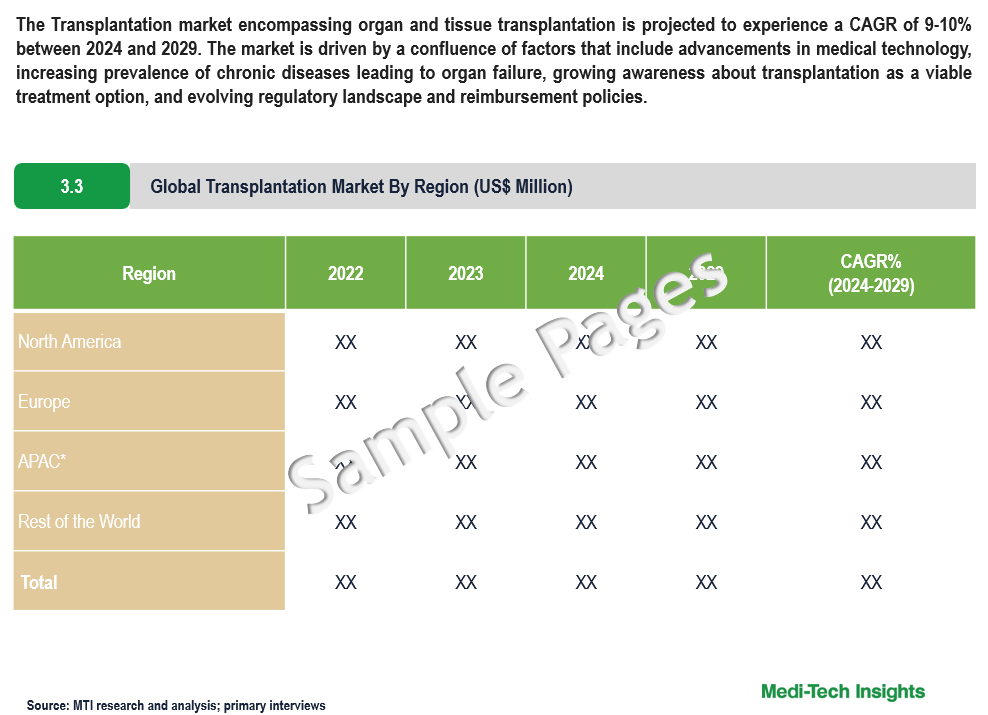
Transplantation Market Size, and Forecast to Expand Amid Technological Advancements and Growth by 2029
The Transplantation market encompassing organ and tissue transplantation is projected to experience a CAGR of 9-10% between 2024 and 2029. The market is driven by a confluence of factors that include advancements in medical technology, increasing prevalence of chronic diseases leading to organ failure, growing awareness about transplantation as a viable treatment option, and evolving regulatory landscape and reimbursement policies. To learn more about the research report, download a sample report.
Transplantation, in the medical context, refers to the surgical procedure of transferring cells, tissues, or organs from one person (the donor) to another person (the recipient) to replace damaged or malfunctioning body parts. The goal of transplantation is to restore normal function to the recipient's body or improve their quality of life. Transplantation is often used to treat end-stage organ failure, severe injuries, certain cancers, or congenital defects that cannot be adequately managed through other medical interventions. It is a complex and highly specialized field of medicine that requires careful matching of donors and recipients, rigorous surgical techniques, and ongoing post-transplant care to ensure successful outcomes. Some of the transplantation techniques are classified into the following types:
- Kidney Transplantation: Kidney transplantation involves the transplantation of a healthy kidney from a living or deceased donor to a recipient with end-stage renal disease (ESRD)
- Liver Transplantation: Liver transplantation is the surgical replacement of a damaged or diseased liver with a healthy liver from a living or deceased donor. This procedure is typically performed in patients with advanced liver diseases, such as cirrhosis
- Heart Transplantation: Heart transplantation involves the replacement of a damaged or failing heart with a healthy heart from a deceased donor. This procedure is performed in individuals with severe heart failure that does not respond to other medical treatments
- Corneal Transplantation: Corneal transplantation, also known as corneal grafting, involves replacing a damaged or diseased cornea with a healthy cornea from a deceased donor. This procedure is commonly performed to restore vision in individuals with corneal diseases or injuries
- Bone Marrow Transplantation: Bone marrow transplantation, also known as hematopoietic stem cell transplantation, involves the transfer of healthy stem cells from a donor to a recipient to treat various blood disorders, such as leukaemia, lymphoma, or aplastic anaemia
- Skin Transplantation: Skin transplantation involves grafting healthy skin onto a recipient to treat extensive burns, wounds, or other skin conditions. This procedure can be autologous (using the patient's skin) or allogeneic (using donor skin)
Impact of Disease Trends and Aging Population on Transplantation Services
The rising incidence of diseases such as diabetes, chronic kidney disease, and liver cirrhosis has contributed to the increasing demand for organ transplantation. As these conditions progress, they often lead to organ failure, necessitating transplantation as a life-saving intervention. Additionally, the aging population globally has led to a greater prevalence of conditions like end-stage renal disease and heart failure, further driving the need for transplantation services. Public awareness campaigns and educational initiatives have played a crucial role in fostering a better understanding of transplantation among patients, caregivers, and healthcare providers. Increased awareness about the importance of organ donation, coupled with initiatives to streamline the organ procurement and allocation process, has helped mitigate organ shortages in some regions and facilitated timely access to transplantation for patients in need. Moreover, the transplantation market is subject to regulatory influences, encompassing policies governing organ procurement, allocation, and reimbursement. Government-led initiatives designed to encourage organ donation, enhance transplant infrastructure, and promote fair access to transplantation services profoundly shape market dynamics. Additionally, alterations in reimbursement policies and healthcare reimbursement systems can impact the economic feasibility of transplantation procedures, thereby influencing the decision-making of healthcare providers.

To learn more about this report, download the PDF brochure
Transformative Innovations in Transplantation: Pioneering Breakthroughs
One of the key growth drivers is technological advancements in transplantation procedures and immunosuppressive therapies. Innovations such as minimally invasive surgical techniques, better organ preservation methods, and improvements in tissue matching algorithms have significantly improved transplant success rates and patient outcomes. Moreover, the development of novel immunosuppressive drugs with improved efficacy and reduced side effects has expanded the pool of eligible transplant recipients and enhanced long-term graft survival. Moreover, innovations in organ bioengineering and 3D printing hold promise for creating personalized, immunocompatible organs using a patient's cells, potentially eliminating the need for lifelong immunosuppression. For instance,
- In September 2023, United Therapeutics Corporation revealed the attainment of two significant milestones in its xenotransplantation initiatives: the completion of the second UHeart™ xenoheart transplant into a living recipient, and a 61-day examination of the UThymoKidney™ xenokidney and thymus in a pre-clinical human model
- In February 2022, Orthofix Medical unveiled Opus BA, a synthetic bioactive bone graft solution tailored for cervical and lumbar spine fusion surgeries, designed to effectively fill bone voids or gaps within the skeletal system
Gene editing technologies are paving the way for inducing transplant tolerance and safer procedures by modifying the immune response to transplanted organs. Additionally, xenotransplantation is emerging as a viable strategy to address organ shortages, leveraging advancements in genetic engineering and infectious disease control. Cell therapy and regenerative medicine approaches offer the potential for repairing damaged tissues and promoting post-transplantation regeneration. Precision medicine principles, coupled with biomarker discovery efforts, are enhancing our ability to predict transplant outcomes and detect rejection episodes early, guiding personalized treatment strategies. These transformative innovations collectively contribute to the growth of the transplantation market, which is expected to continue expanding in the coming years.
Key Constraints/Challenges
The transplantation market faces several challenges hindering its growth. Organ shortages remain a critical issue, leading to long waiting lists and delays in treatment for patients. Additionally, the immune system's response to transplanted organs can result in rejection, necessitating lifelong immunosuppressive therapy with associated risks and complications. Surgical complexity poses another hurdle, as transplantation procedures require specialized expertise and infrastructure. Moreover, the high costs involved in transplantation, including surgery and post-transplant care, can limit access for patients without adequate financial resources. Ethical and legal considerations, such as organ trafficking and equitable access to transplantation services, further complicate the landscape, requiring careful attention and oversight. Addressing these challenges will be essential for advancing the transplantation field and improving patient outcomes.
Regional Segmentation of the Autoimmune Disease Diagnosis Market
North America comprises countries with advanced healthcare systems, such as the United States and Canada, which boast well-established transplantation programs and high organ donation rates. These nations benefit from robust regulatory frameworks like the United Network for Organ Sharing (UNOS) in the US. Similarly, Europe encompasses a diverse range of countries with varying levels of transplantation infrastructure and regulatory frameworks. Western European countries like Germany and Spain lead in advanced medical technologies supporting transplantation services.
In the Asia-Pacific region, the combination of rapid economic growth, increased healthcare spending, and growing awareness of organ donation is driving market growth. This dynamic region encompasses diverse transplantation landscapes, including countries such as China, Japan, and India. While China has been actively expanding its transplantation infrastructure despite ethical challenges, Japan and India are witnessing rising demand for transplantation services. Both countries are actively enhancing their transplant infrastructure and regulatory frameworks to meet this growing need.
Competitive Landscape
Some of the key players operating in the market include Arthrex, AbbVie, Teva Pharmaceuticals, Medtronic PLC, Zimmer Biomet, Strykers, Novartis AG, Veloxis Pharmaceuticals and BiolifeSolutions, among others.

Get a Sample Report for Competitive Landscape Analysis
Organic and Inorganic Growth Strategies Adopted by Players to Establish Their Foothold in the Market
Players operating in this market are adopting both organic and inorganic growth strategies such as collaborations, and acquisitions to garner market share. For instance,
- In July 2022, Carl Zeiss Meditec and Precise Bio announced a collaboration wherein they will jointly develop 4D bio-fabricated corneal transplants, moreover, Carl Zeiss Meditec will invest in Precise Bio, providing funding for the continued development of Precise Bio's two cornea transplant products, and securing exclusive worldwide commercialization rights for these innovative products
- In March 2022, Biocomposites finalized a multi-year partnership with Zimmer Biomet for the exclusive distribution of Genex Bone Graft Substitute, along with its innovative mixing system and delivery alternatives, within the U.S. orthopaedic market
- In September 2021, Sanofi finalized a definitive merger agreement with Kadmon Holdings, Inc., aimed at bolstering Sanofi's General Medicines core assets and promptly incorporating Rezurock (belumosudil), a newly FDA-approved, first-of-its-kind treatment for chronic graft-versus-host disease (cGVHD) in adult and pediatric patients aged 12 years and older who have unsuccessfully undergone at least two prior lines of systemic therapy, into its transplant portfolio.
The transplantation market is expected to gain momentum in the coming years due to the rising incidences of chronic diseases, an increasing number of transplant surgeries, growing awareness about organ donation and technological advancements, and aggressive organic and inorganic growth strategies followed by the players.
Key Strategic Questions Addressed
-
What is the market size & forecast for the Global Transplantation Market?
-
What are the historical, present, and forecasted market shares and growth rates of various segments and sub-segments of the Global Transplantation Market?
-
How has COVID-19 impacted the Global Transplantation Market?
-
What are the major growth drivers, restraints/challenges impacting the market?
-
What are the opportunities prevailing in the market?
-
What is the investment landscape?
-
Which region has the highest share in the global market? Which region is expected to witness the highest growth rate in the next 5 years?
-
Who are the major players operating in the market? What is the competitive positioning of key players?
-
Who are the new players entering the market?
-
What are the key strategies adopted by players?
- Research Methodology
- Secondary Research
- Primary Research
- Market Estimation
- Market Forecasting
- Executive Summary
- Market Overview
- Market Dynamics
- Drivers
- Restraints
- Opportunities
- Market Dynamics
- Global Transplantation Market - Size & Forecast (2021-2028), By Product Type
- Organ Preservation Products
- Transplant Diagnostics
- Tissue Products
- Other Products
- Global Transplantation Market - Size & Forecast (2021-2028), By Application Type
- Kidney
- Liver
- Pancreas
- Heart
- Other Applications
- Global Transplantation Market - Size & Forecast (2021-2028), By Transplant Type
- Autografts
- Allografts
- Other Types
- Global Transplantation Market - Size & Forecast (2021-2028), By End User
- Hospitals
- Transplant Centers
- Academic & Research Institutes
- Other End Users
- Global Transplantation Market - Size & Forecast (2021-2028), By Region
- North America (U.S. & Canada)
- Europe (UK, Germany, France, Italy, Spain, Rest of Europe)
- Asia Pacific (China, India, Japan, Rest of Asia Pacific)
- Rest of the World (Latin America, Middle East & Africa)
- Competitive Landscape
- Key Players and their Competitive Positioning
- Competitive Positioning of Key Players (2022)
- Offerings Assessment, By Players
- Key Strategies Assessment, By Player (2021-2023)
- New Product Launches
- Partnerships, Agreements, & Collaborations
- Mergers & Acquisitions
- Other Developments
- Key Players and their Competitive Positioning
- Key Companies Scanned (Indicative List)
- Arthrex,
- AbbVie
- Teva Pharmaceuticals
- Medtronic PLC
- Zimmer Biomet
- Strykers
- Novartis AG
- Veloxis Pharmaceuticals
- BiolifeSolutions
- Other Players
The study has been compiled based on extensive primary and secondary research.
Secondary Research (Indicative List)

Primary Research
To validate research findings (market size & forecasts, market segmentation, market dynamics, competitive landscape, key industry trends, etc.), extensive primary interviews were conducted with both supply and demand-side stakeholders.
Supply Side Stakeholders:
- Senior Management Level: CEOs, Presidents, Vice-Presidents, Directors, Chief Technology Officers, Chief Commercial Officers
- Mid-Management Level: Product Managers, Sales Managers, Brand Managers, Business Development Managers, Consultants
Demand Side Stakeholders:
- Stakeholders in Hospitals, Transplant Centers, and Academic & Research Institutes among others
Breakdown of Primary Interviews

Market Size Estimation
Both ‘Top-Down and Bottom-Up Approaches’ were used to derive market size estimates and forecasts.
Data Triangulation
Research findings derived through secondary sources & internal analysis were validated with Primary Interviews, Internal Knowledge Repository, and Company Sales Data.


